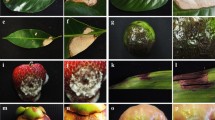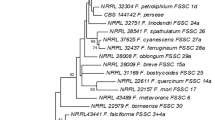Abstract
Gloeosporium musarum is one of the most important fungi causing rotting of banana fruits during transport and storage1,2. Although the fungus is of greatest commercial concern when acting as a post-harvest wound parasite, it also infects unwounded immature fruit in the field2–4. These early infections do not become manifest until the fruit starts to ripen after harvest; such infections are known as ‘latent infections’. The basis of latency in G. musarum was elucidated by Simmonds3 and Chakravarty5. In a water film on the fruit surface, conidia of G. musarum germinate within 4 h. After elongating for a variable distance, the germ tube swells at the tip to form an appressorium. After 24–72 h, a fine infection hypha grows from the appressorium and pierces the cuticle by mechanical means. No further penetration occurs until the fruit starts to ripen. Simmonds3 concluded that this subcuticular hypha is the form in which the fungus survives its period of latency, which may exceed 5 months in Australia. When the fruit is mature, the subcuticular hypha resumes activity and penetrates the cellulose wall of the epidermis cell; the fungus then spreads through the tissues to cause a typical anthracnose lesion.
This is a preview of subscription content, access via your institution
Access options
Subscribe to this journal
Receive 51 print issues and online access
$199.00 per year
only $3.90 per issue
Buy this article
- Purchase on Springer Link
- Instant access to full article PDF
Prices may be subject to local taxes which are calculated during checkout
Similar content being viewed by others
References
Meredith, D. S., Trop. Agric. Trin., 38, 205 (1961).
Wardlaw, C. W., Banana Diseases (Longmans, Green, 1961).
Simmonds, J. H., Proc. Roy. Soc. Queensland, 52, 92 (1941).
Simmonds, J. H., and Mitchell, R. S., Counc. Sci. Indust. Res. (Austral.) Bull. No. 131 (1940).
Chakravarty, T., Trans. Brit. Mycol. Soc., 40, 337 (1957).
Meredith, D. S., Trans. Brit. Mycol. Soc., 44, 95 (1961).
Meredith, D. S., Trans. Brit. Mycol. Soc., 45, 137 (1962).
Meredith, D. S., Ann. App. Biol., 51, 29 (1963).
Meredith, D. S., Ann. App. Biol. (in the press).
Meredith, D. S., Ann. App. Biol. (in the press).
Baker, R. E. D., and Wardlaw, C. W., Ann. Bot., 51, 59 (1937).
Wardlaw, C. W., Baker, R. E. D., and Crowdy, S. H., Trop. Agric. Trin., 16, 275 (1939).
Author information
Authors and Affiliations
Rights and permissions
About this article
Cite this article
MEREDITH, D. Appressoria of Gloeosporium musarum Cke. and Massee on Banana Fruits. Nature 201, 214–215 (1964). https://doi.org/10.1038/201214a0
Issue Date:
DOI: https://doi.org/10.1038/201214a0
Comments
By submitting a comment you agree to abide by our Terms and Community Guidelines. If you find something abusive or that does not comply with our terms or guidelines please flag it as inappropriate.



